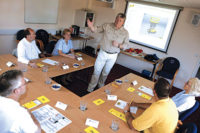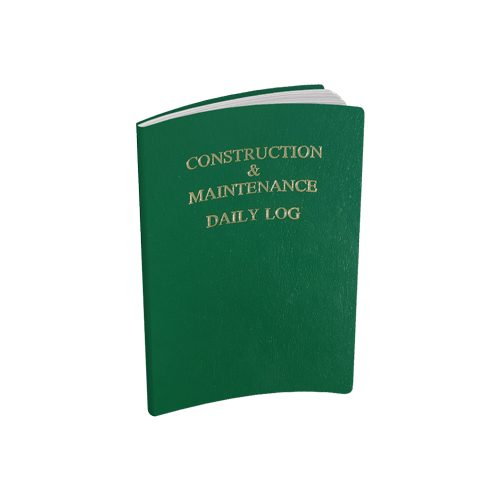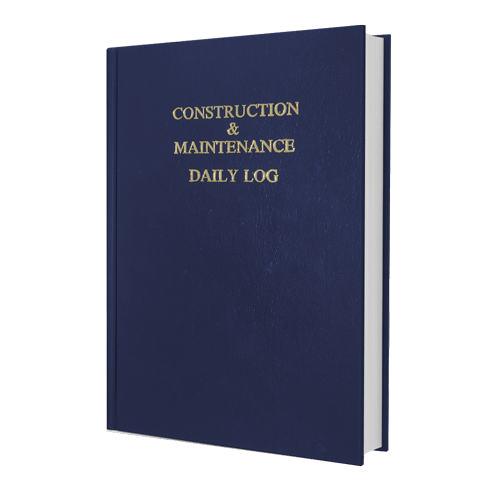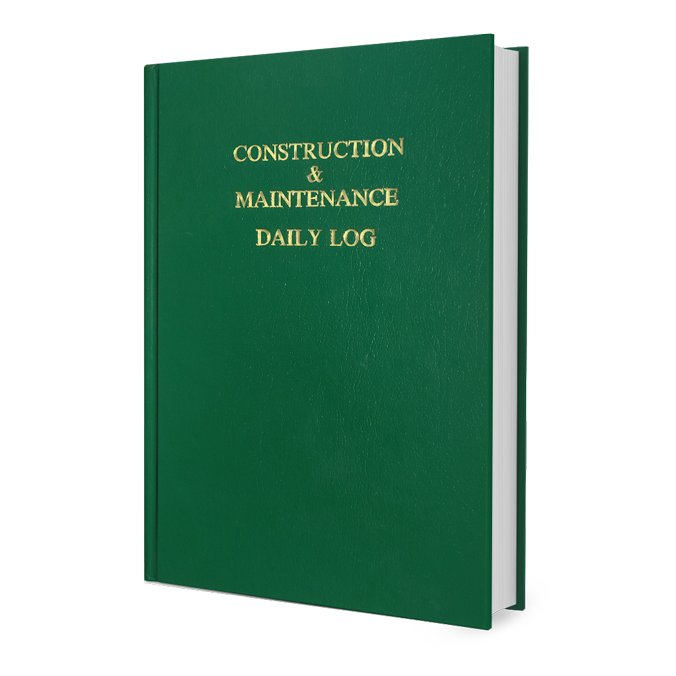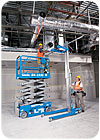
Photo
supplied by Genie Industries.
Subcontractors that perform exterior plastering, drywall, ceiling installation, metal framing, and other services are likely to utilize aerial lifts or mast climbing platforms to increase the safety and effectiveness of their workers. Today’s design and options for this equipment have added to the ability to gain access to work at height safely. However, this equipment must be properly maintained and operated by qualified personnel to make them safe and effective. Employers who direct and authorize their employees to operate this equipment must be aware of their responsibilities to ensure this takes place. Below we will examine your responsibilities when using scissor lifts.
Aerial lifts are regulated under OSHA 1926.453 Aerial Lifts. Scissor lifts, including those with platforms that extend beyond the equipment’s wheelbase, do not fall within any of the categories defined there. Therefore, scissor lifts are not addressed by the aerial lift provisions in OSHA’s Subpart L. While there are no OSHA provisions that specifically address scissor lifts, they do meet the definition of a scaffold (§1926.451-general requirements for scaffolds). Employers must therefore comply with the other applicable provisions of Subpart L when using scissor lifts. For example, since scissor lifts are mobile, the specific requirements for mobile scaffolds in the scaffold standard (§1926.452(w) - mobile scaffolds) must be met. Is that clear? Probably not, so let’s look elsewhere for direction. The ANSI standard A92.6-2006 for Self Propelled Elevating Work Platforms covers scissor lifts. A copy of this Manual of Responsibilities should be in the black weatherproof box on the platform of every operational scissor lift.
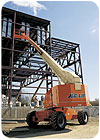
Photo
supplied by JLG.
You may own or rent the scissor lift you use for your work. Owning adds other levels of responsibility. As owner, you have the responsibility to maintain a copy of the operating, maintenance, repair and parts manuals. You are required to maintain, inspect and repair the equipment in accordance with the manufacturer’s recommendations. Frequent inspections must be performed every three months or 150 hours of use, whichever comes first. An annual inspection must be completed no later than 13 months from the date of the prior annual inspection. The inspection must be performed by a person qualified as a mechanic on the specific make and model of the aerial lift or one having similar design characteristics. The owner shall train their maintenance personnel in the inspection and maintenance in accordance with the manufacturer’s recommendations.
Use by Others
As an owner, if you rent or provide the lift for any form of beneficial use (loan/borrow by others), you are required to perform a pre-delivery preparation (inspect and adjust). You are required to familiarize the person designated by the receiving entity that the manuals for the machine are in place, to review the control functions and safety devices for the specific model being delivered. The owner is also responsible to assist the user and operators relating to rated capacity, intended use, maintenance, repair inspection, or operation of the aerial lift. You can’t just give someone the key to your machine and walk away.
Familiarization
Familiarization upon delivery is not training, rather the information regarding the control functions and safety devices for the aerial platform to a qualified person or operator who controls the movement of the lift. This information must be conveyed to any trained operator prior to their use of the aerial lift. Each machine may have unique control functions and operations and unique safety devices. This information enables a trained operator to recognize how to safely operate that specific machine. (See Familiarization Technical Guidance AWPTF1 atawpt.org.)
Operator Training
When an owner directs or authorizes an employee to operate an aerial platform (loading, unloading, inspecting, or any form of use) the owner shall ensure that the person has been trained, familiarized and made aware of the responsibilities of an operator as outlined in the ANSI standards. This requirement exists whenever an employer directs or authorizes an employee to operate an aerial lift, regardless if the aerial lift is owned-rented-leased-etc. Training is defined as the instructions to enable a trainee to become a qualified person regarding the task to be performed, including knowledge regarding potential hazards. It is unrealistic to expect training to take place when a lift is delivered to a job site.
Still on the topic of training, if you are renting equipment you take the title user as defined by ANSI. Whether you are an owner or a user, you are required to train and familiarize the operator on the specific unit being operated and additionally retrained, if necessary, based on the user’s observation and evaluation of the operator. This is an important responsibility of a user (employer).
The ANSI standard states the user shall monitor the performance and supervise their work to ensure the use, application, and operation of the aerial lift is in conformance with the standard, and to warn against hazards, provide means to protect against the hazards and explain the potential consequences of not following proper operating guidelines. ANSI defines 37 issues and subjects that need to be included in those instructions and guidelines, such as fall protection, slope and grade, distribution of load, etc.
When a rental company delivers an aerial lift, they are required to provide the familiarization to the person designated by the receiving party. The intent is to have either a qualified person or the operator of that lift be the one assigned to receive this information. If a qualified person receives the information, they can convey the information to the assigned operator of the lift. If for some reason, you do not accept the familiarization at point of delivery, you are still responsible to ensure anyone that you direct or authorize to operate the lift is both trained and familiarized. Do not take lightly the responsibility of providing familiarization to trained operators.
Prestart Inspection
As an entity that has care, custody and control of an aerial lift, you are required to perform a prestart inspection before use each day or at the beginning of each shift. This is a visual inspection and function test that includes 10 specific items listed in the ANSI standard. It includes items from the operating and safety controls to all items specified by the lift’s manufacturer.
Record Retention
Regardless of whether you own or rent an aerial lift, required records must be maintained for four years. Required records include names of individuals trained, retrained and familiarized and the name of trainer(s), clear identification of training covered, date of training, written records of frequent and annual inspections and repairs, and pre-delivery preparation.
All aerial lifts are safe and effective tools to assist when working at heights. The responsibilities above summarize some of the specific requirements defined in the ANSI standard. You will need to review the document to be fully aware of all the requirements in the standard for the safety of all. An analysis of the changes made to the ANSI standards in 2006 can be found at AWPT’s Web site (awpt.org). W&C

